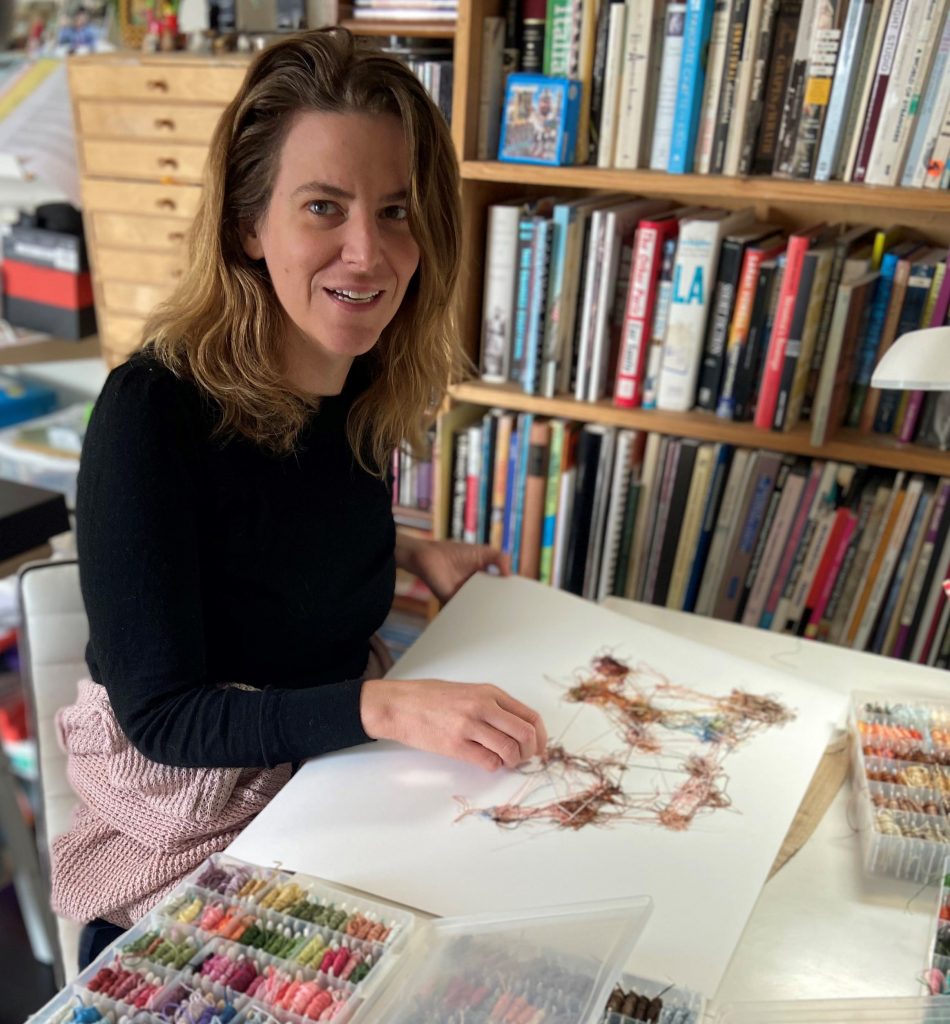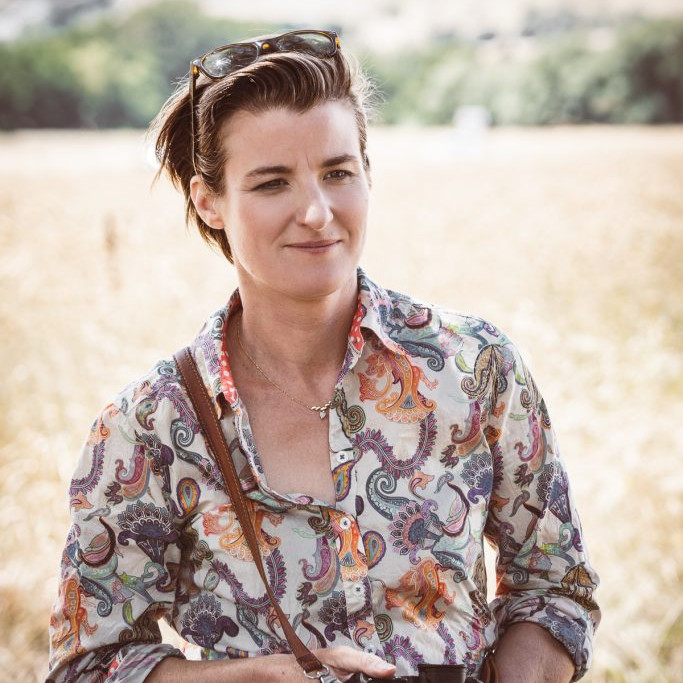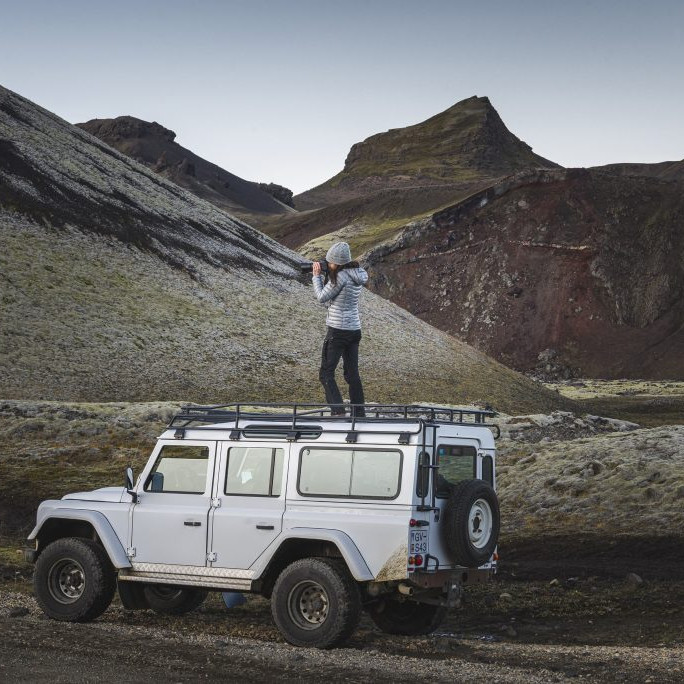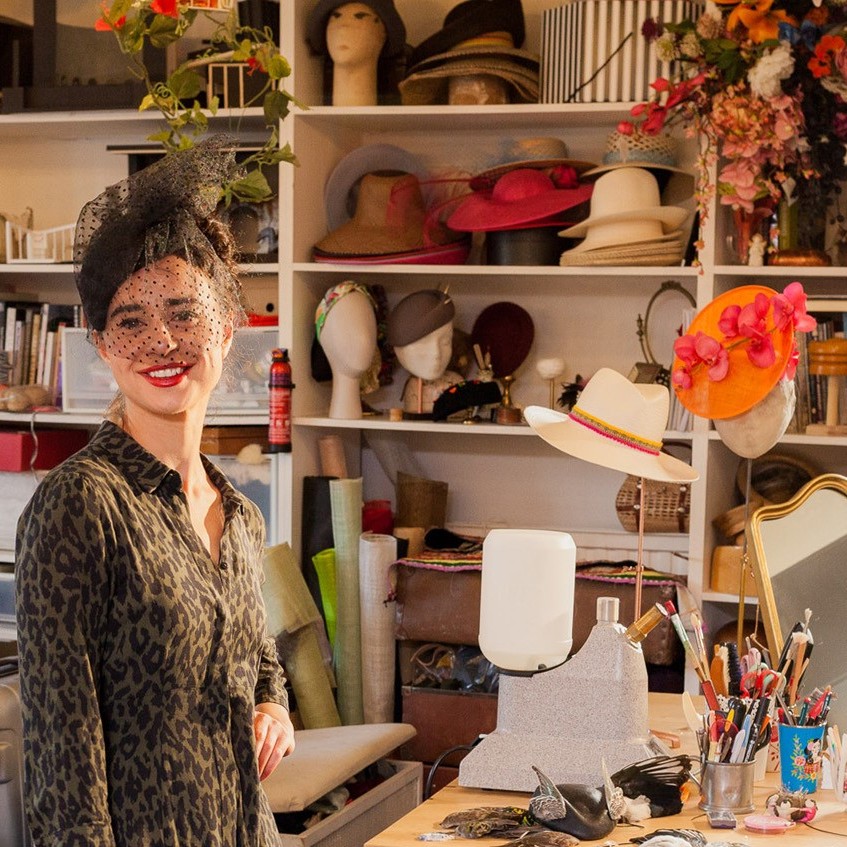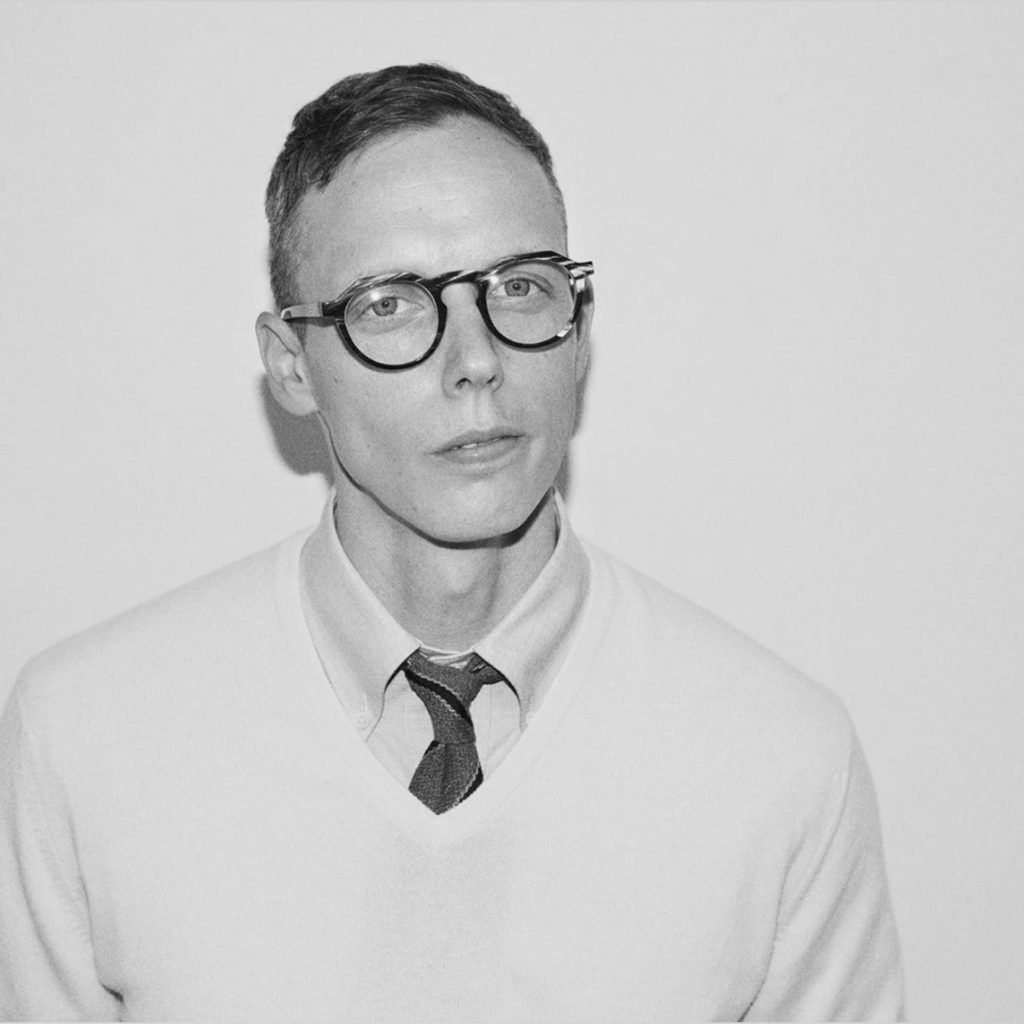Diane Meyer Photographer / Textile Artist
When did you first combine stitch with photograph?
I’ve been embroidering into photographs since 2011. Initially, I was interested in combining a traditional, analogue process with the visual language of digital imaging. I was also interested in returning to the physicality of the photograph and the notion of the photograph as object- something that becomes increasingly lost in the digital age. Through experimentation, I started sewing in a manner that aesthetically appeared as pixelization. As much of my work deals with issues related to personal and collective memory, I started thinking about the relationship between forgetting and digital file corruption- particularly given how photographs are strongly tied to and ultimately often replace memory.
A long time ago, I was working on a series of landscapes using small squares of carpet remnants which also created a pixelated effect. Although I didn’t realize it at the time, I think the embroidered photographs came from my original experiments using carpet remnants.
The process has developed into three different bodies of work. One series consists of images taken in Berlin and follows the path of the former Berlin Wall in the city center and the outer suburbs.
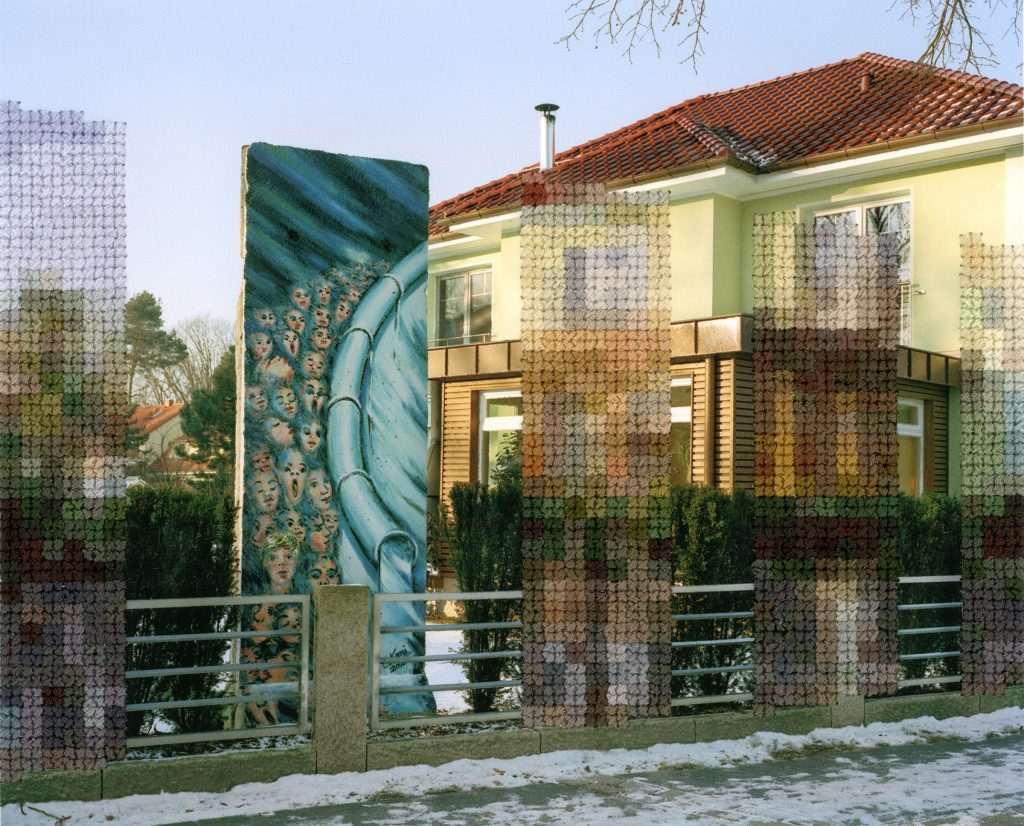
Yard and Remaining Wall Panel, Hermsdorf, Hand Sewn ARchival Ink Jet Print, 5.5×6.75 inches, 2019
The second series is based on snapshots and personal photographs taken at various times throughout my life and organized by location.
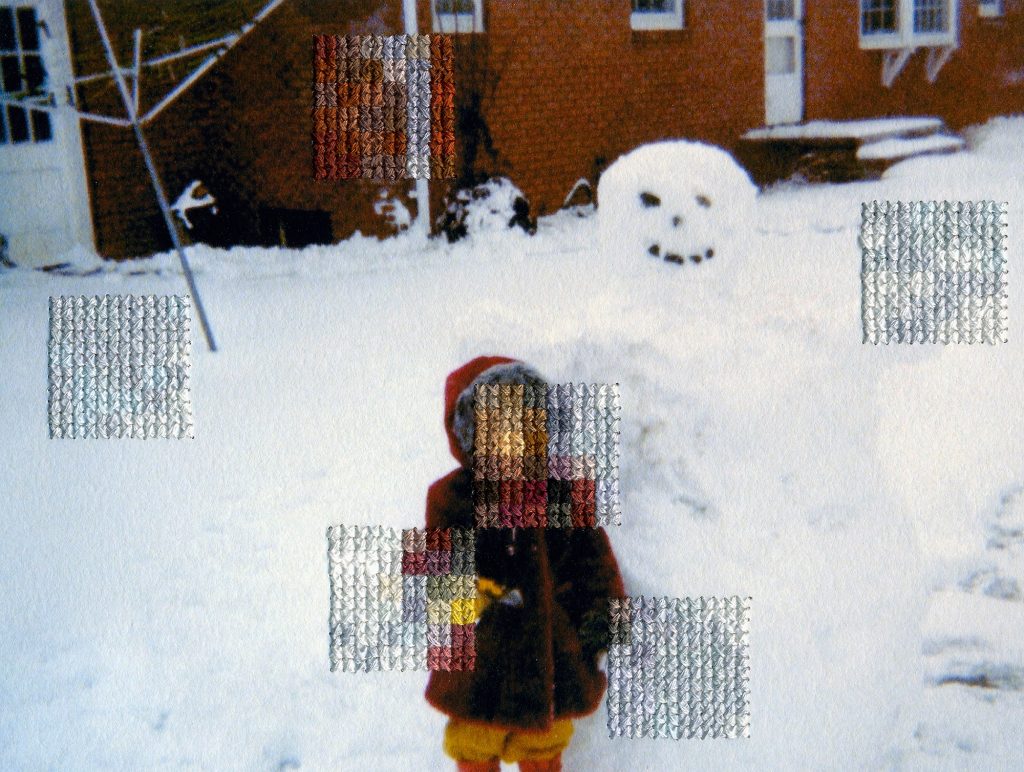
New Jersey III, Hand Sewn ARchival Ink Jet Print, 6.25 x 7.5 inches, 2011
The third series, which I am currently working on, is based on found class photos.
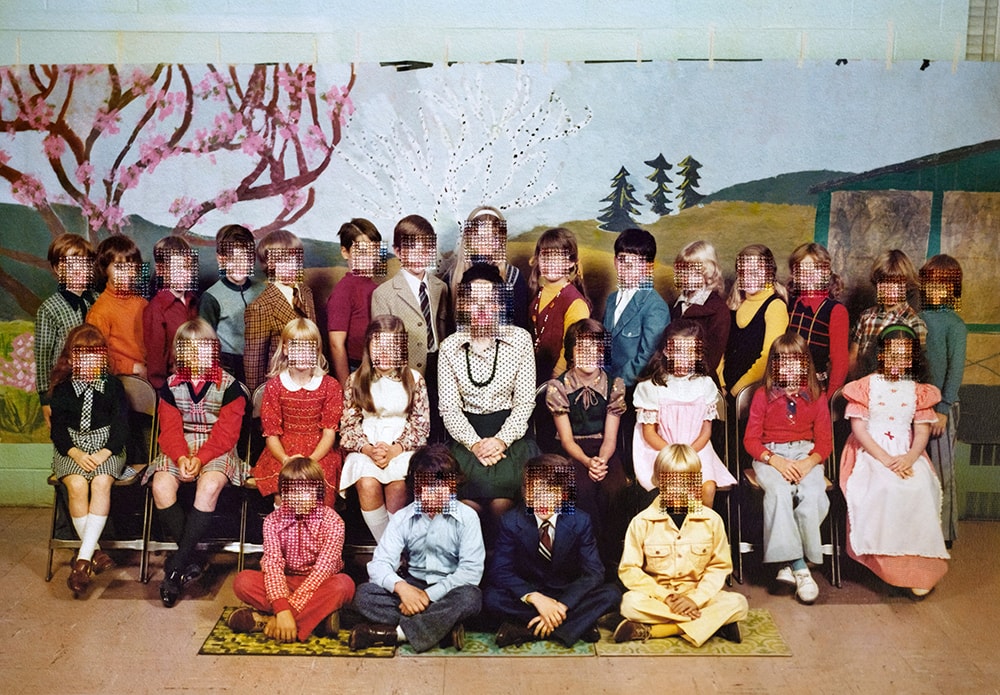
Group I, Hand Sewn ARchival Ink Jet Print, 7×9 inches, 2016
‘New Jersey III’ please expand on the addition of colour through each small cross stitch section.
This piece is from the series, Time Spent That Might Otherwise Be Forgotten. In this series, cross stitch embroidery has been sewn directly into family photographs.
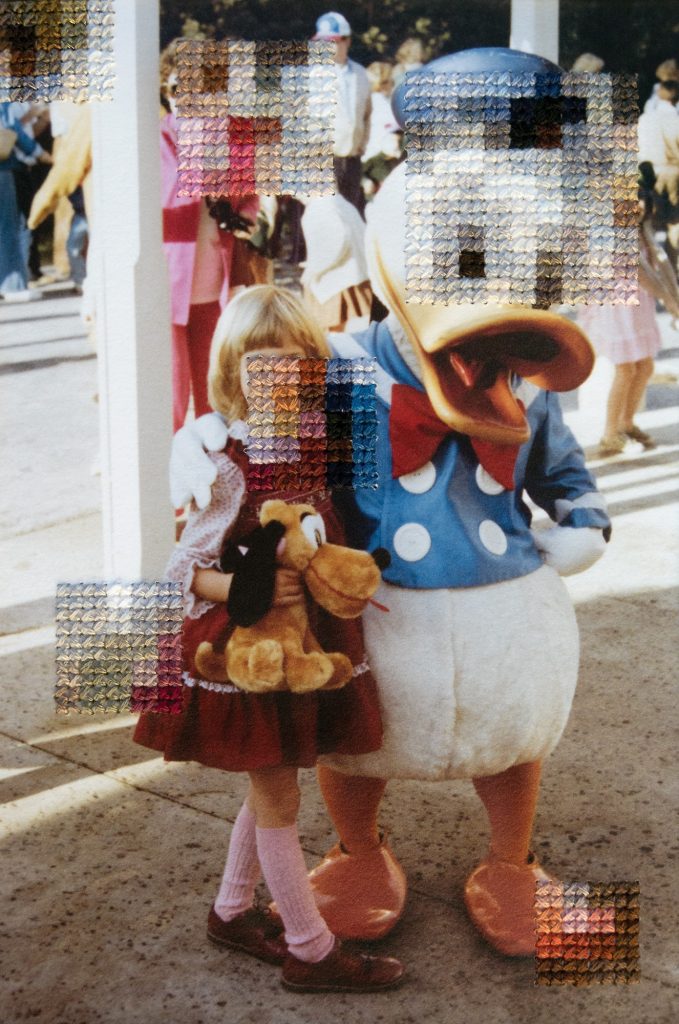
Disneyland I, Hand Sewn ARchival Ink Jet Print, 7×5 inches, 2013
The images are broken down and reformed through the embroidery into a hand-sewn pixel structure. As areas of the image are concealed by the embroidery, small, seemingly trivial details emerge while the larger picture and context are erased. I am interested in the disjunct between actual experience and photographic representation and photography’s ability to supplant memory. By borrowing the visual language of digital imaging with an analog process, a connection is made between forgetting and digital file corruption. The tactility of the pieces also references the growing trend of photos remaining primarily digital- stored on cell phones and hard drives, but rarely printed out into a tangible object.
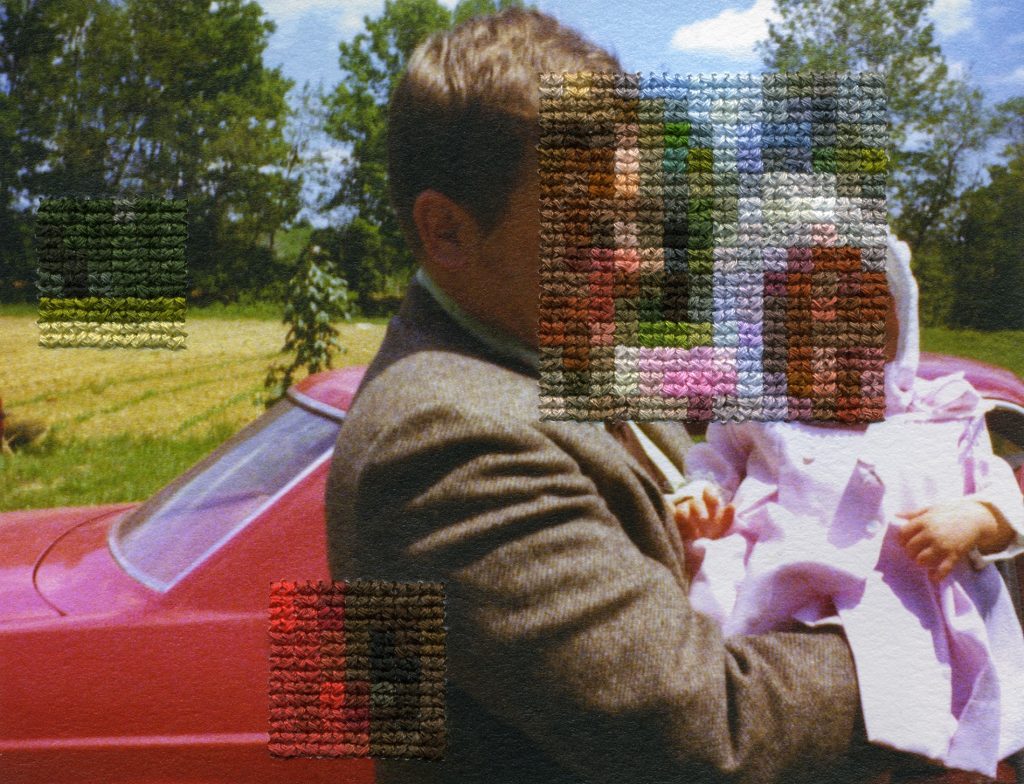
New Jersey XVI, Hand Sewn ARchival Ink Jet Print, 4.5×6 inches, 2016
This series draws largely on family photographs and was taken of me by my mother- probably around 1979 or 1980. The colors of the thread were selected to match the colors in the photograph- predominately white for the snow and reds and browns for the coat and the bricks in the house in the background.
In general, I try to place the sewn pixelated areas in the areas that would normally be the most important parts of the image, or where one’s eye would typically gravitate towards first- people’s faces, important details, etc. In this way, these areas become erased, and the viewer is forced to only look at the unimportant details of the image- such as wallpaper or other small details. I wanted the embroidery to block the viewer- both by being slightly raised above the picture plane and also by covering the faces of the figures or main vantage points- the areas that one would normally look at first in a photograph.
I also wanted to cover the faces of the individuals to make the themes of memory and nostalgia more universal for the viewer. Since everyone’s photo albums show the same kind of scenes, I wanted the viewer to be able to insert themselves into the images or relate them to their own photo albums. At the same time, I wanted the images to also be a bit unsettling psychologically.
When did you begin to increase, the amount of stitch on each photograph? How large are some of your photographs?
I started drastically increasing the amount of embroidery on each piece with the Berlin series. The images in Time Spent That Might Otherwise Be Forgotten are relatively small as I wanted them to maintain the intimate experience of looking at a family photograph. They are roughly about 25% larger than the original photograph, ranging in size from 4×6 to 9×12 inches. In the Berlin series, the sizes range much more widely. The number of stitches is always the same, so the size of the image itself varies based on how much detail I want to maintain in the embroidered sections. When pieces are smaller, the Wall becomes a bit more abstract while in larger pieces, the embroidered areas show the detail of what is behind the surface of the embroidery. The largest piece, Brandenburg Gate, is 14×16” has over 17,000 stitches, but I knew I wanted this piece to be large so that the embroidery maintain the detail of the tourists taking photographs and cyclists, giving the impression of them being almost suspended in the Wall.
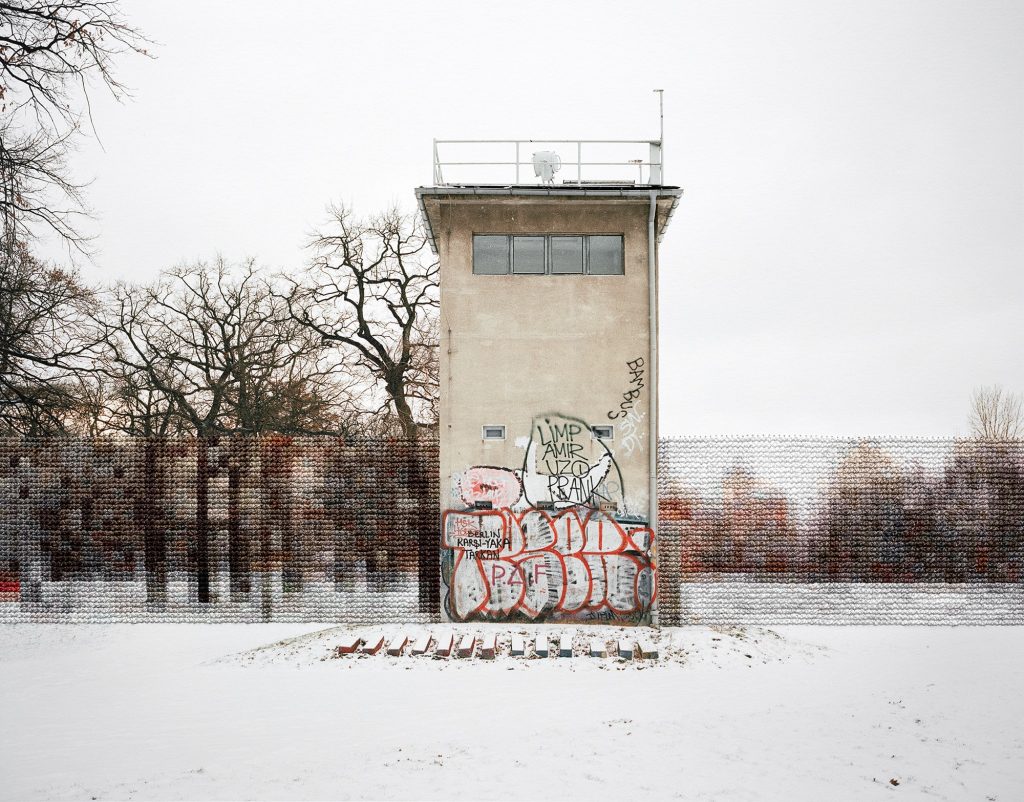
Former Guard Tower Off Puschkinallee, Hand Sewn ARchival Ink Jet Print, 11.25×14 inches, 2013
The smallest piece in the series is 2 x 3.5 inches. The series Reunion based on class photographs are consistent in size, 14.5 x 21.5 inches.
Are all the photographs yours, especially some of the earlier work?
The photographs in the Berlin series are all my own and were taken in 2012 and 2013 and were taken with a medium format film camera. The images in Time Spent that Might Otherwise Be Forgotten, are a combination of family photographs and my own photographs. As this piece serves as an archive and photo diary of memories throughout my life, the early images in which I am a child were taken by family members while the landscapes and later snapshots were taken by me. There is a class photograph in this series which was my brother’s class photo, but the class photos in the Reunion series are found photographs.
Can you take us through you work, Berlin 2012 – Present?
There are a total of 43 images in the completed Berlin series..
I did not initially go to Berlin with the intention of doing this project. I went to the city for several months beginning in January 2012 for an artist residency. I initially intended to continue the series I was working on that was based on family photographs,I realized the issues I was working on around memory could be extended to the collective memory of the Wall. By re-inserting the Berlin Wall through embroidery, a pixelated view of what is behind the wall is seen, creating the effect of an almost ghost-like trace in the landscape. While I was in Berlin, I was especially interested in the ways that the wall still felt very present even when it is no longer there.
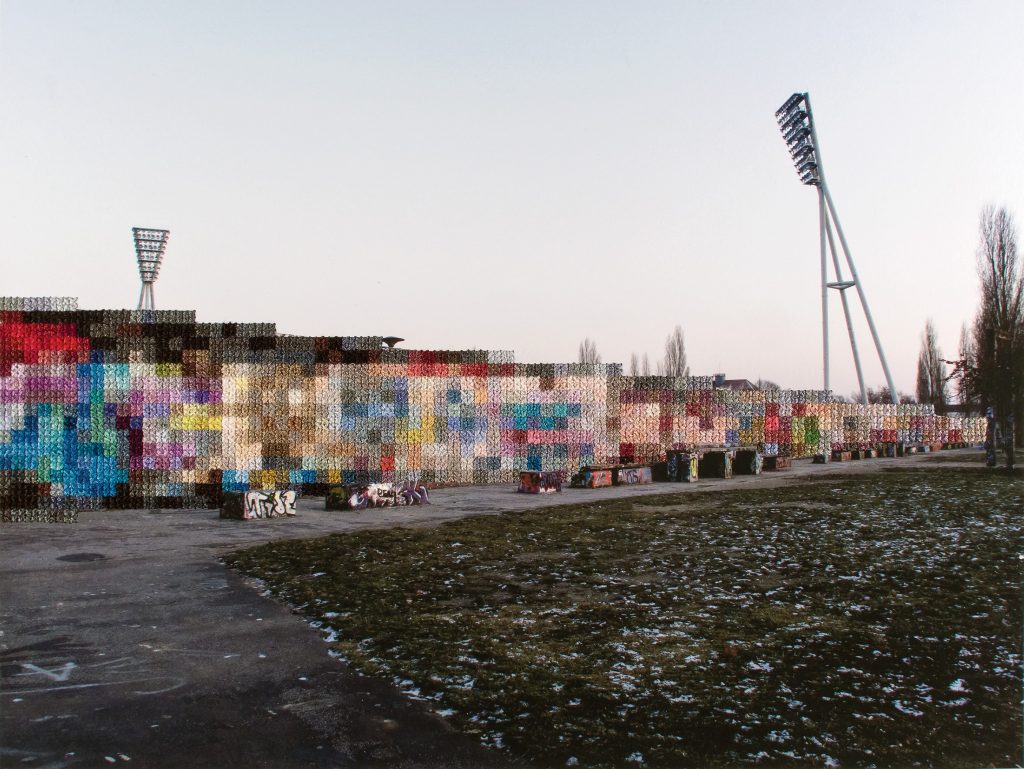
Mauer Park, Hand Sewn Archival Ink Jet Print, 8.5×11 inches, 2012
I was 13 when the Wall fell and have a very clear memory of watching it on television. However, once I came to Berlin, I realized how much I didn’t know about it, and wanted to learn more. I hadn’t realized how big the Wall was (roughly 100 miles) and how deep it extended into the suburbs and forests- or even that it was a ring that completely isolated West Berlin from the rest of West Germany. I also became very interested in trying to find subtle clues that remained in the landscape even when the Wall was no longer there- small patches of trees that were smaller than others nearby, open plots of land, new construction, architectural discrepancies in some of the suburban neighborhoods, old street lamps facing the wrong way, etc.
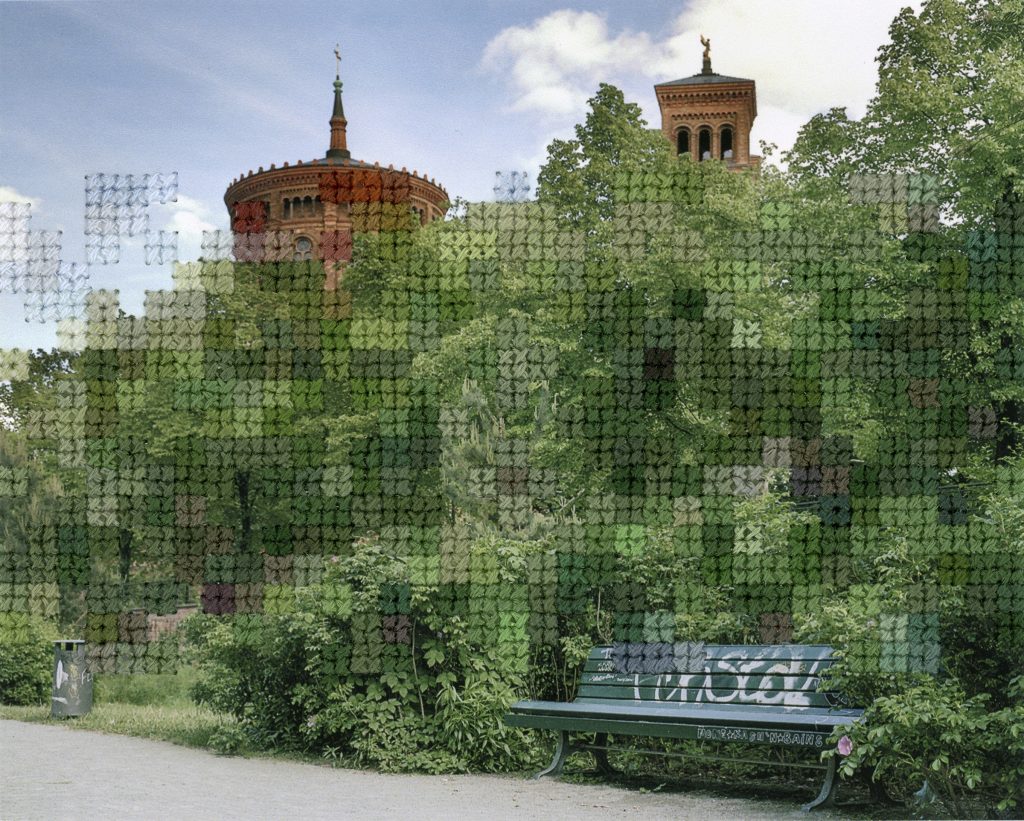
Engeldamm, Hand Sewn ARchival Ink Jet Print, 4×5 inches, 2019
Following the path of the wall also provided me with an opportunity to get out of the city center and explore parts of the city and surrounding areas I would not have otherwise gone.
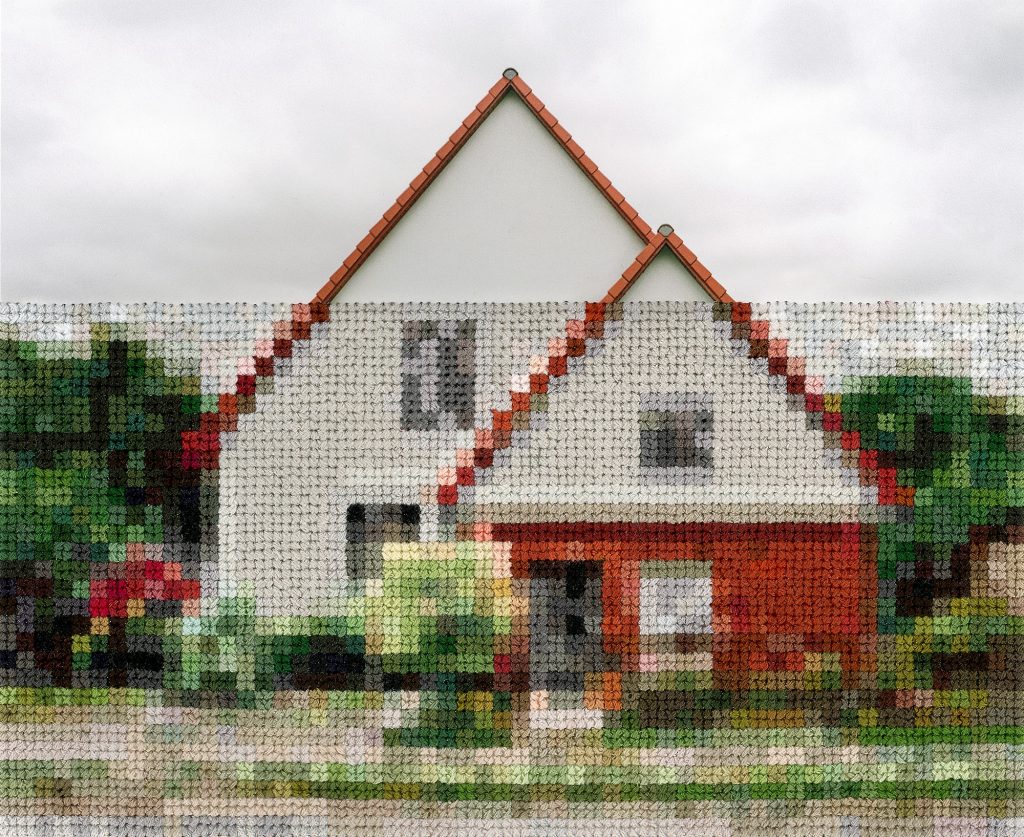
House, Former Wall Area Near Lichterfelde-Süd, Hand Sewn ARchival Ink Jet Print, 5×7 inches, 2017
The path of the Wall was not very difficult to follow. I primarily used an app of the Berlin Wall which was released by the Zentrum für Zeithistoriche Forschung Potsdam, the Bundezentrale für Politische Bilding and Deutschlandradio. The app shows the overlay of where the inner and outer wall had been over a GPS Google Map. There is a paved bicycle path that roughly follows approximate path of the Wall. I generally biked on this path, but then used the app to get to the border in places were the bicycle path veered away from the precise border.
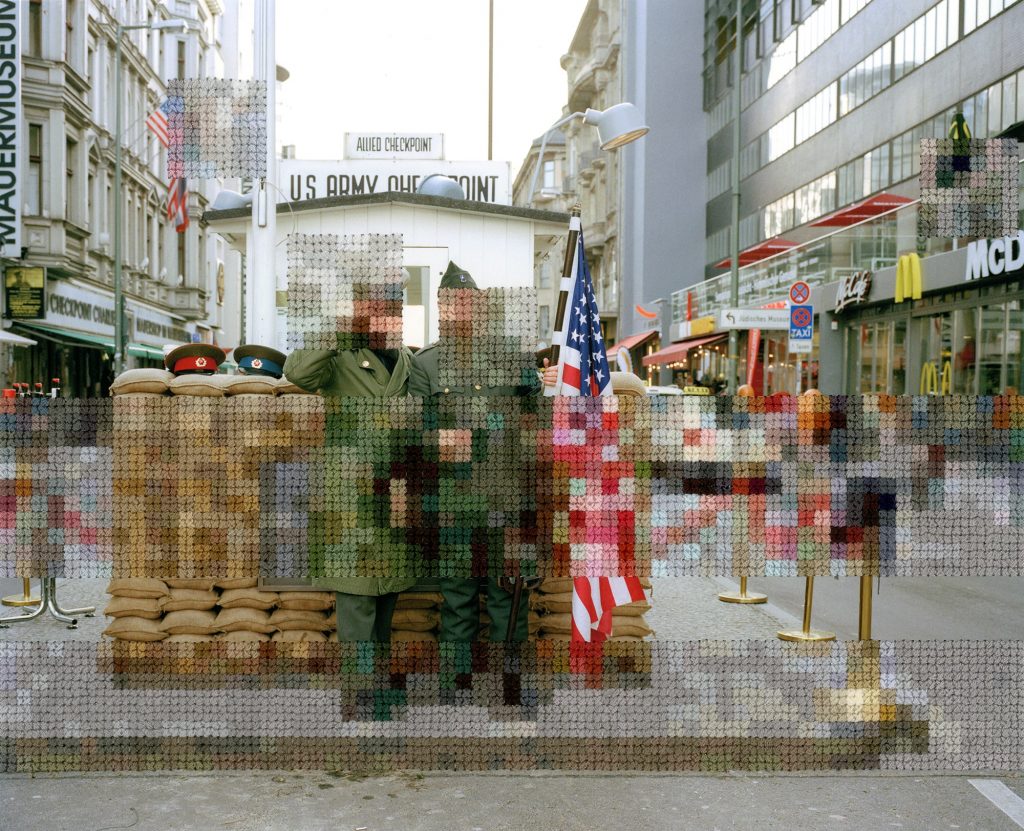
Checkpoint Charlie, Hand Sewn ARchival Ink Jet Print, 7×9 inches, 2015
In the city center, the path of the Wall is largely marked with paved stones indicating where it had been. The city center is so built up, making it difficult to imagine the Wall having divided very vibrant neighborhoods in the relatively recent past. However, on the outskirts of the city center, particularly near Neikölln or Alt-Treptow or Plänterwald there were empty tracts of land or construction sites which provided an indication of where the Wall had been. In Hermsdorf, I saw really dramatic changes in the architecture of suburban neighborhoods indicating the newer homes which had been built in the areas that opened up after the Wall fell.
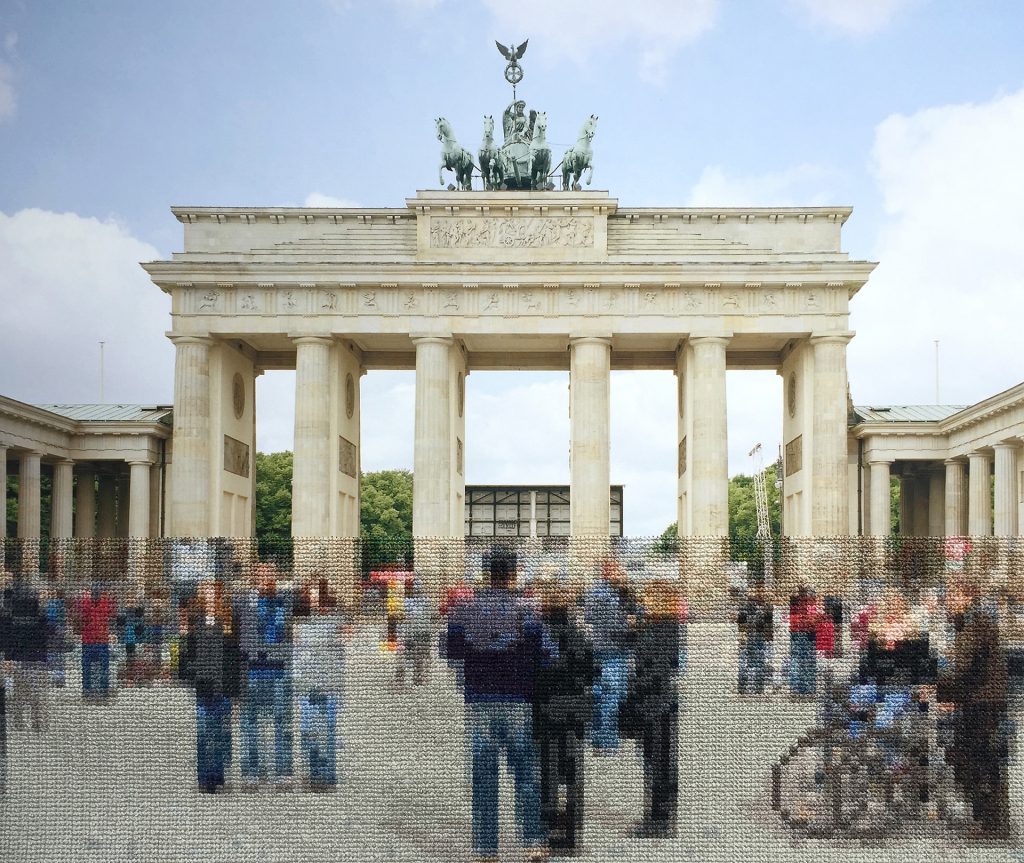
Brandenburg Gate, Hand Sewn ARchival Ink Jet Print, 14×16 inches, 2015
After working on this project what have been some amazing stories others have shared with you?
Unfortunately, have not been able to speak to many Berliners who lived through the Wall about the project. My great grandparents immigrated to the US in the 1890s, and although I have German ancestry on both sides of my family, I unfortunately do not speak German, so I was not able to speak with as many locals as I would have wanted- particularly in the East. Also, many of the locals whom I met where more recent transplants to the city and did not have the experience of having grown up surrounded by the Wall. I am hoping to have the opportunity to show the work in Berlin sometime in the future as I would really love to hear the perspectives of people in the local population.
Discuss the digital aspect of your work.
The film or photographs and scanned and I am sewing into Archival Ink Jet Prints.
By borrowing the visual language of digital imaging with an analog process, a connection is made between forgetting and digital file corruption. The tactility of the pieces also references the growing trend of photos remaining primarily digital- stored on cell phones and hard drives, but rarely printed out into a tangible object.
When do you know how to stop stitching so that the two mediums are still independent while still connected?
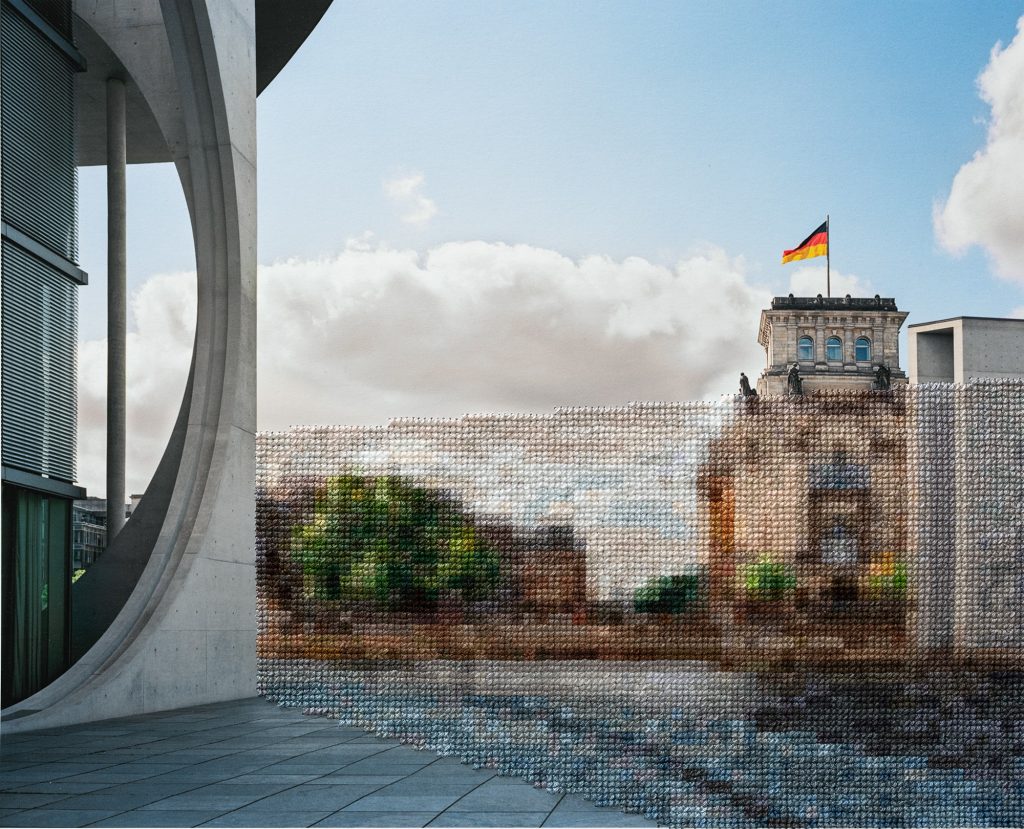
Reichstag, Hand Sewn ARchival Ink Jet Print, 9.5×12 inches, 2019
This is something I’ve been experimenting with. It is important to me that the two medium are independent from one another to a certain extent, but have been experimenting on how much of the photograph needs to be present for it to still be photographic. This is something I’ve been thinking about for a new project. In the image, House, Former Wall Area Near Lichterfelde-Süd, the image is mostly embroidered with just a bit of the rooftop visible. But I’ve been thinking about what if only the sky or a particular colour was visible through the stitching. In other images, such as Heidelberger Staße, the wall is only slightly visible in the frame.
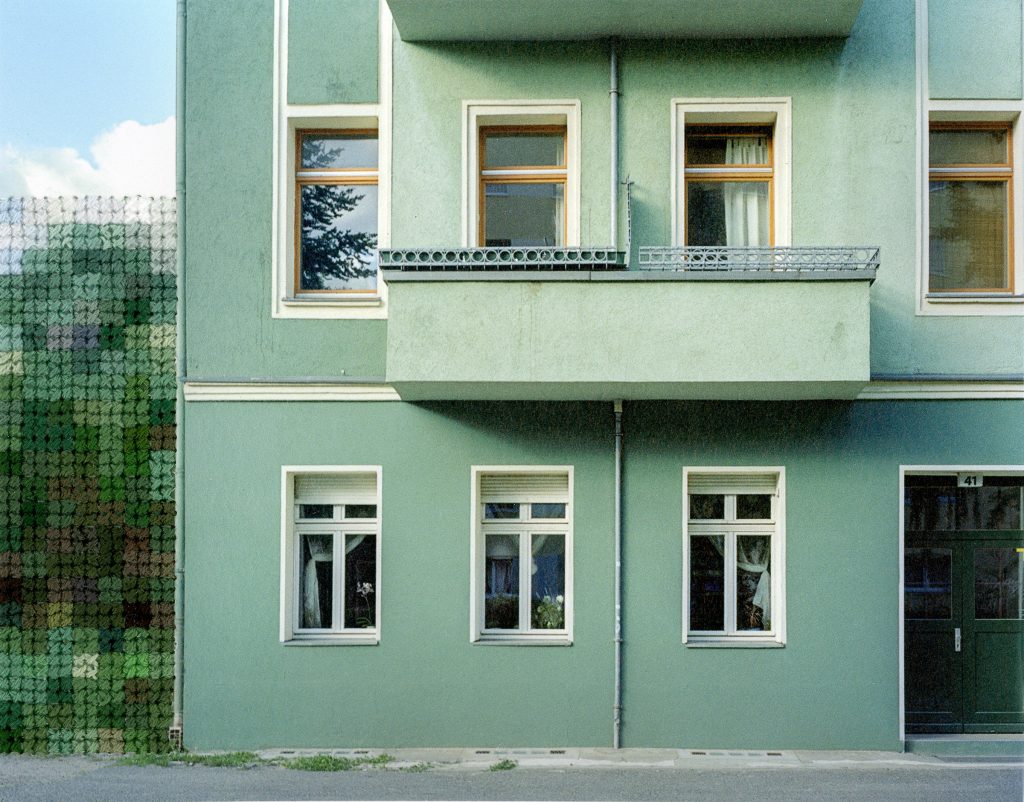
Heidelberger STraße, Hand Sewn ARchival Ink Jet Print, 4×5 inches, 2019
How many prints do you make of each image?
The pieces are created in an edition of three with 2 artist proofs. Because each work is hand embroidered, there are minor variations between each edition, but they are essentially identical.
Discuss the importance of history to your artistic practice.
Photography is of course an important part of understanding history and maintaining records. It is also a way for a viewer to emotionally connect to the past in a way that would be difficult to do through just the written word. However, it is a deeply flawed mechanism for truly understanding the past given how subjective and how easy it has always been to manipulate photography well before the advent of Photoshop.
In a museum or an archive, narratives about the past are created based on the artifacts that remain. Therefore, stories are created based on fragments and empty spaces are filled in through speculation. Historical photographs are the same in many ways. Particularly because not as many survive- fewer were taken and the negatives or prints have been lost through the years. Those that survive become puzzle pieces to a past that needs to be filled in.
Places are always changing and evolving and, while photographs leave out lots of information, it is a useful tool to preserve what something physically looked like in the past. I was reminded of this when finishing the Berlin series. I was trying to find the original locations of the photographs when I was giving them titles. In some cases, I knew the general area where the photo was taken but had forgotten the street name. I looked at google maps and satellite views to find the locations where I had shot the images and, in several cases, was surprised to see that places that had been empty lots or fields when I took the photographs in 2012 and 2013 now were filled with new construction.
I think in some ways, Photography plays an even more important role today in preserving history. As photography becomes an even more democratic medium with camera phones putting the ability to document the world in the hands of so many people, digital imaging allowing for an unlimited amount of images to be taken, and social media giving everyone a platform to place their images in the public realm, every event has a multitude of image makers, both professional and amateur, documenting history and allowing it be simultaneously seen from multiple vantage points.
History also has the ability to change the meaning of photographs. The Berlin Wall is a symbol of injustice, lack of freedom and inhumanity. When I started this project in 2012, Barrack Obama was the president and I never would have imagined how delicate and fragile our democracy would now feel just seven years later. Just as the meaning of photographs change over time based on the cultural or historic moment, sadly, the implications and meanings of this project have changed for me in ways I didn’t expect given the current moment.
What has drawn you to Elementary School class photos?
Most recently, I have been working on a series of hand-embroidered photographs based on found elementary school class pictures from the 1970s. This project continues my interest in the relationship between photography and memory and grew out of an earlier project- while working on the series Time Spent That Might Otherwise Be Forgotten, I included a class photograph of my brother’s elementary school class.
But while looking at the image, I was struck by the psychologically unsettling nature of the photograph, but also the uniformity- how the students were all posed in a very particular and formal way. I started collecting class photographs from around the country and became interested in how not matter where the school was located- across various states, both rural and urban communities, the poses were always identical.
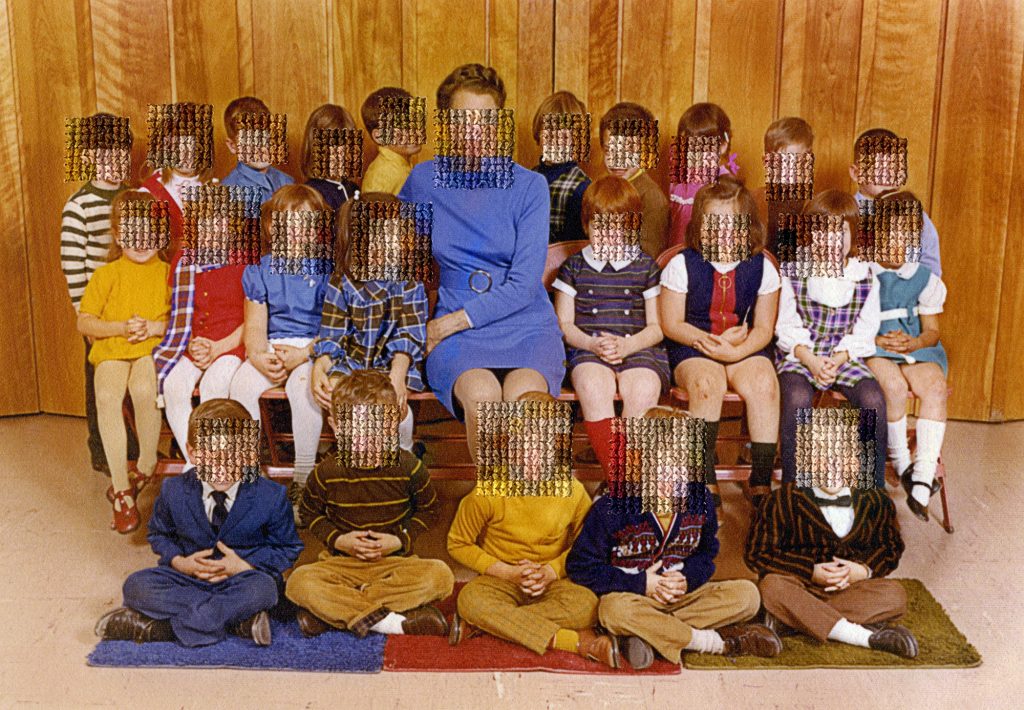
Bogert School ( Class Three) Hand sewn Archival Ink Jet Print, 14.5 x 21.5” 2019
In the class photographs, the faces of the students, or what would normally be the main focal points of the image, are obscured with cross-stitch embroidery made to resemble the digital pixel structure of the image. By obscuring what would typically be the most important parts of the image, otherwise overlooked details are brought into focus such as body language and other embodiments of social convention. I am interested exploring these details to reveal not only the relationships between the various figures, but also how, even at a very young age, children were taught and instructed to pose in particular ways, often based on gender. I am interested in this time period not only because it is my own generation, but also because it is the last generation to have a childhood unclouded by digital technology. I’ve been interested in how our relationship to photographs has changed in the digital age. These class pictures were taken before camera phones and digital cameras and at a time when having one’s class picture taken was a more formal occasion- something that has been lost due to the ubiquitous nature of digital photography- making participants more conscious of the photograph as a vehicle for impression management.
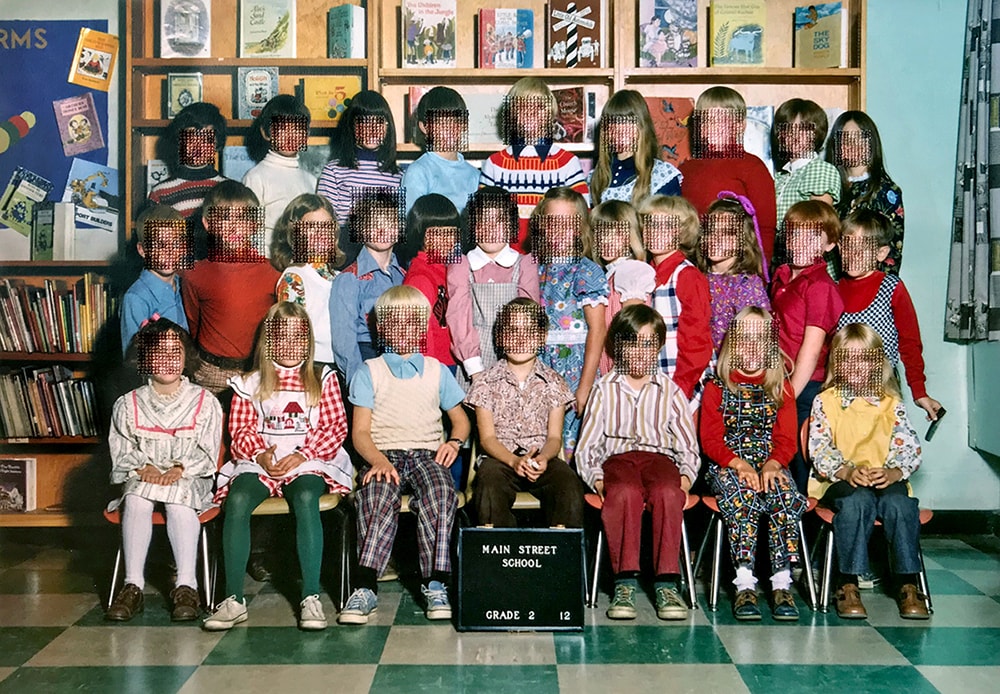
Main Street (Class One) Hand sewn Archival Ink Jet Print, 14.5 x 21.5” 2018
I then began the series I am currently working on now, Reunion, based on these photographs.
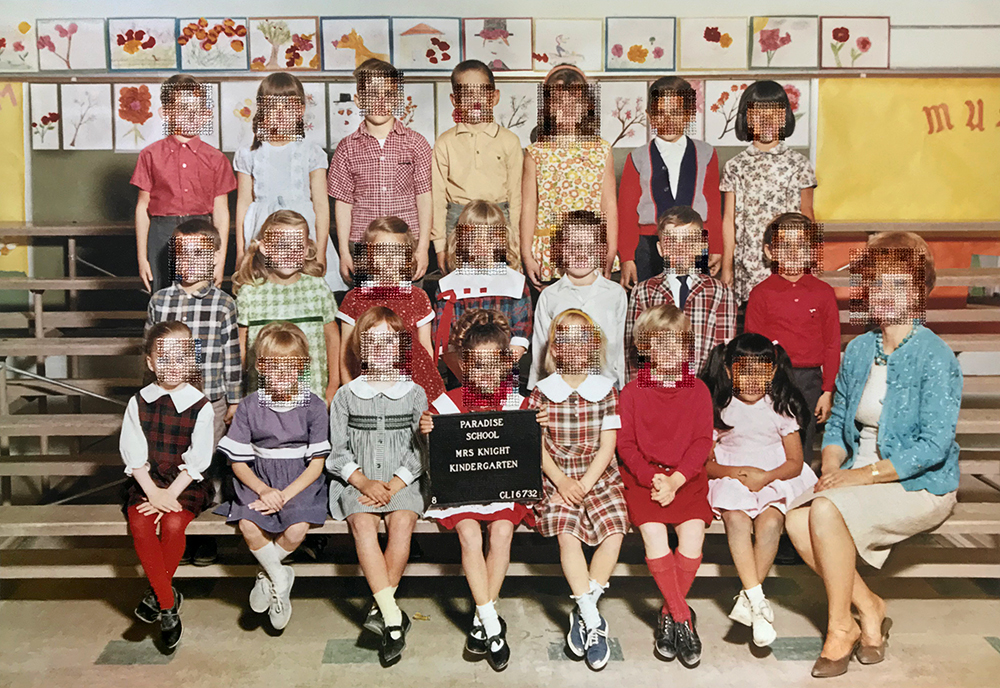 Paradise School (Class One) Hand sewn Archival Ink Jet Print, 14.5 x 21.5” 2018
Paradise School (Class One) Hand sewn Archival Ink Jet Print, 14.5 x 21.5” 2018
Contact:
Diane Meyer
www.dianemeyer.net
dianemeyer213@gmail.com
@dianemeyerstudio
Deborah Blakeley, Melbourne, Australia
Interview by Deborah Blakeley, March 2020
Think a colleague or friend could benefit from this interview?
Knowledge is one of the biggest assets in any business. So why not forward this on to your friends and colleagues so they too can start taking advantage of the insightful information the artist has given?
Other artists you may be interested in:


